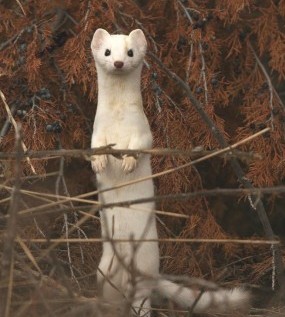There are two species of weasels in Alaska: the short-tailed weasel or ermine (Mustela erminea) and the least weasel (Mustela rixosa). These weasels range over North America and are found throughout most of Alaska. Neither weasel is found on the offshore islands of the Bering Sea or the Aleutian Islands west of Unimak Island. In addition, the least weasel does not occur on the Kodiak Archipelago or on most islands in Southeast Alaska. The short-tailed weasel occurs in the Old World where it is known by the name of “stoat.”
Though they may look like cute pets, ermines, or short-tailed weasels, are some of the fiercest little predators in Alaska. Of course they are not dangerous to humans. In fact, you'd be lucky to even see an ermine in the wild. They are swift, silent creatures that can hunt and burrow in the forest and tundra unnoticed. Ermines are mostly nocturnal, which means they spend most of their time moving and hunting at night. When you first see it, an ermine might seem like it wouldn't survive in cold Alaskan weather. They have small heads with short, round ears and long whiskers that are extremely sensitive to touch. The ermine's eyesight is not particularly good, although it sees much better at night. They are small animals with short legs and thin bodies that usually don't grow much longer than a foot.
Unlike other arctic animals, ermines don't store large amounts of fat. Their hearts beat too quickly and they usually burn the necessary calories they get from food by the end of the day. But ermines have soft warm fur that provides them cover and warmth in all seasons. They do not hibernate, but will hunt all year long. Their fur is usually reddish brown in the spring and summer months. They have tan-colored, almost white fur on their bellies, and long tails with furry, black tips. In the winter, the ermine's coat will turn completely white, except for the tip of the tail. Ermines can blend into their snowy winter homes and stealthily hunt and kill their prey.
At only about 1-foot long and weighing only 7 ounces, a short-tailed weasel is a very muscular, agile, curious and bold creature sometimes known for climbing up peoples clothing to retrieve food. Ermine generally eat mice, cotton tails, small hares, porcupines, rats, frogs, fish and insects. The ermine population fluctuates according to the abundance of food. The predators of ermines are coyotes, badgers, foxes, birds of prey and wolverines.
Weasels are primarily solitary animals except during the mating and whelping seasons. Reproductive pairing is usually temporary. Females may be bred by more than one male. Mating typically occurs in mid-to late summer. Fertilization of the ova is followed by a period during which the eggs do not implant in the uterus. No development occurs during this period. This process is called delayed implantation. After 6 to 7 months the fertilized ova implant in the uterus and embryos begin to develop. The total gestation span is 8 to 10 months.
In the southern portion of their geographic range they can produce three litters per year. In Alaska, litters of 3 to 10 young are born from early May through June. Variations in time of breeding and birth depend in part on the latitude. Weasels in northern Alaska breed about two weeks later than those in the south.
Weasels usually nest in small rodent burrows, stumps, rock outcroppings, or under old buildings. The nest is often lined with mouse fur. The number of young born and the number that survive until weaning depend in large part on the abundance of food in the mother's home range. Young weasels remain in the den for 30 to 45 days, at which time they are about two-thirds grown.
After emerging, they stay near the home den for a week or two before beginning to accompany their mother on foraging trips. At 80 to 85 days of age (early fall) they reach full size. At this time, they disperse away from their mother's home range. Sexual maturity is reached by the following spring. Like all weasels the ermine is hunted for its pelts, however, farmers will kill the ermine not for its furs but to protect his poultry.
As with the least weasel, mouse-like rodents predominate in the ermines diet. However, unlike the least weasel which almost exclusively feeds on small voles, the ermine regularly preys on larger rodents. Typically, male ermine prey on rabbits more frequently than females do, which depend to a greater extent on smaller rodent species.
Short-tailed weasels are an opportunistic predator, which moves rapidly and checks every available burrow or crevice for food. Because of their larger size, males are less successful than females in pursuing rodents far into tunnels. The short tailed weasel regularly climbs trees to gain access to bird's nests, and are common raiders of nest boxes, particularly those of large species.
|
|








